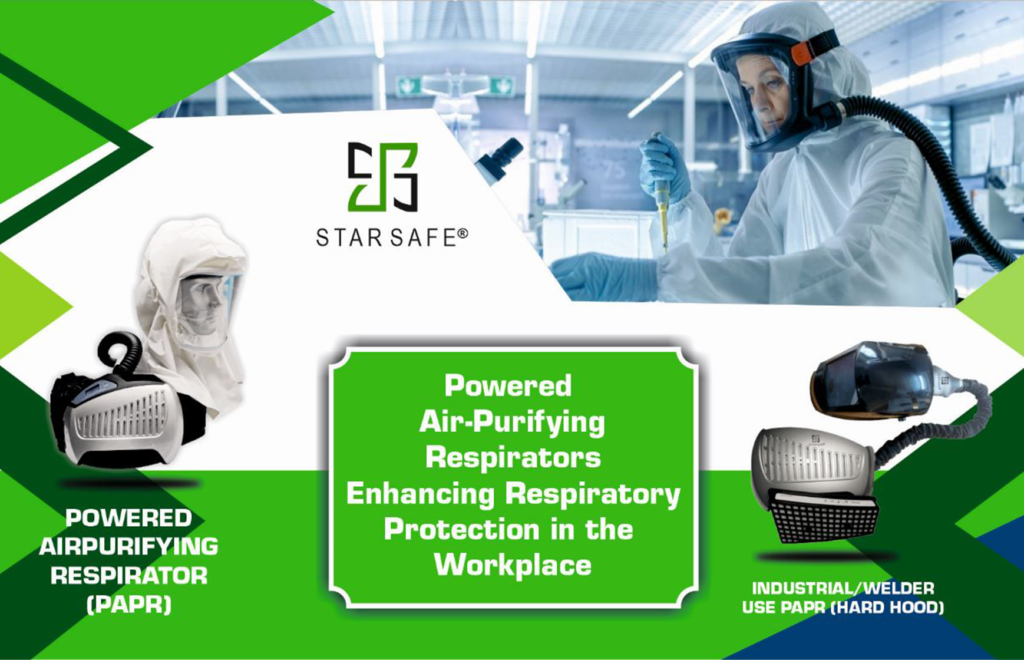
A powered air-purifying respirator (PAPR) is a type of personal protective equipment that uses a motorized air-purifying system to filter out harmful particles and chemicals in the air. This equipment is widely used in various industries, including healthcare, construction, manufacturing, and mining, to protect workers from respiratory hazards.
How does a PAPR work?
A PAPR consists of a battery-powered blower, a filter, and a facepiece or hood. The blower pulls air through the filter, which removes harmful particles and chemicals, and then delivers the clean air to the wearer’s face. The facepiece or hood seals around the wearer’s face or head, preventing contaminated air from entering.
Types of PAPRs
There are two main types of PAPRs: tight-fitting and loose-fitting. Tight-fitting PAPRs use a facepiece that forms a tight seal around the wearer’s nose and mouth, while loose-fitting PAPRs use a hood that covers the wearer’s head and neck. Both types are effective at protecting against respiratory hazards, but tight-fitting PAPRs are more commonly used in healthcare settings, while loose-fitting PAPRs are often used in industrial settings.
Benefits of PAPRs
PAPRs offer several benefits over traditional respirators, such as N95 masks. Firstly, PAPRs provide a higher level of protection since they use a powered air-purifying system to filter out contaminants, while traditional respirators rely on the wearer’s breath to filter the air. Additionally, PAPRs are more comfortable to wear for extended periods since they do not require the wearer to exhale against resistance.
PAPRs are also more effective at preventing contamination since they provide a full face seal, protecting the wearer’s eyes, nose, and mouth. Furthermore, PAPRs can be used for longer periods than traditional respirators, reducing the need for frequent mask changes and increasing overall productivity.
Applications of PAPRs
PAPRs are widely used in various industries to protect workers from respiratory hazards. In the healthcare industry, PAPRs are used to protect healthcare workers from infectious diseases, during procedures that generate aerosols, such as intubation, suctioning, and bronchoscopy.
In the construction and manufacturing industries, PAPRs are used to protect workers from exposure to dust, fumes, and other airborne contaminants. PAPRs are also used in the mining industry to protect workers from exposure to silica dust, which can cause lung cancer and other respiratory diseases.
Limitations of PAPRs
While PAPRs offer many benefits, they also have some limitations that should be considered. PAPRs are more expensive than traditional respirators, and they require regular maintenance, such as filter changes and battery replacements, to ensure their effectiveness. PAPRs also require a power source, which can be a limitation in some environments where electricity is not readily available.
Additionally, PAPRs are not suitable for use in environments with high concentrations of toxic gases or vapors, as they do not provide respiratory protection against these hazards. In these situations, a self-contained breathing apparatus (SCBA) would be a more appropriate form of respiratory protection.
Conclusion
In conclusion, powered air-purifying respirators (PAPRs) are an effective form of respiratory protection in various industries, including healthcare, construction, manufacturing, and mining. PAPRs offer several benefits over traditional respirators, such as higher levels of protection and increased comfort, and are widely used to protect workers from respiratory hazards. However, PAPRs also have limitations that should be considered, such as cost and maintenance requirements.
